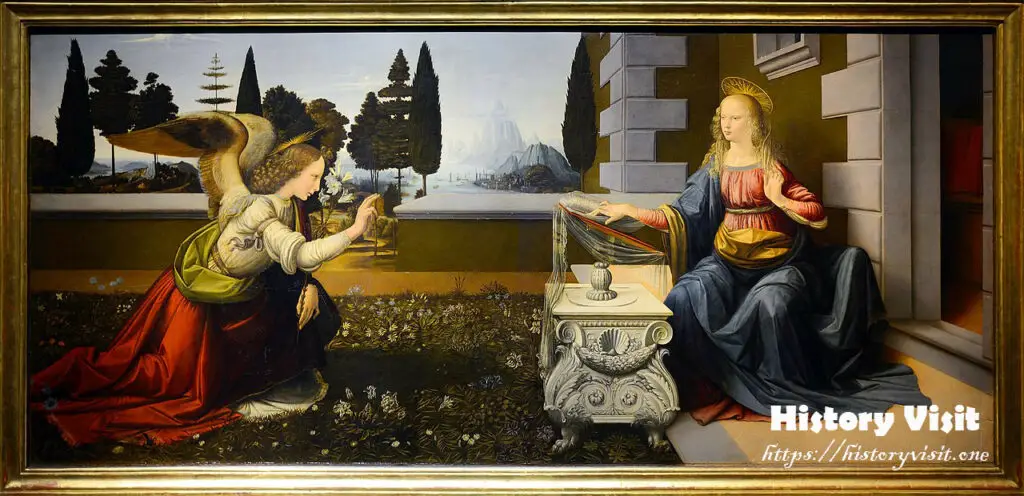Decoding Leonardo da Vinci’s Annunciation: Unveiling the Artistry and Significance

Artist : Leonardo da Vinci
Year : c. 1472–1476
Medium : Oil and tempera on poplar panel
Subject : The Annunciation
Location : Uffizi, Florence
Understanding Leonardo da Vinci’s Annunciation Art
Leonardo da Vinci’s “Annunciation” artwork stands as a testament to the artist’s brilliance and mastery of technique. This iconic piece showcases the convergence of artistic genius and historical significance, offering a glimpse into the Renaissance era. Examining this artwork delves into its symbolism, historical context, and artistic finesse, unravelling layers of meaning and ingenuity.
Unveiling Symbolism and Context
Leonardo da Vinci’s “Annunciation” portrays the biblical scene of the angel Gabriel announcing to the Virgin Mary that she would conceive and bear Jesus. The intricate details, including the architectural elements, the figures’ expressions, and the surrounding landscape, hold profound symbolism. Each aspect contributes to the narrative and theological significance of the artwork.
The Masterful Technique of Leonardo
Leonardo da Vinci, renowned for his exceptional skill in rendering human anatomy and expression, showcases his expertise in “Annunciation.” The careful use of light and shadow, the meticulous detailing of the figures, and the precision in portraying emotions reflect Leonardo’s mastery of the craft.
Exploring Historical and Artistic Context

To truly appreciate “Annunciation,” one must understand its historical context. The Renaissance marked a period of intellectual, artistic, and cultural resurgence in Europe. Leonardo’s artwork embodies the Renaissance ideals of humanism, scientific inquiry, and artistic innovation, making it a quintessential representation of the era.
The Complexity of Symbolism
The symbolism within “Annunciation” extends beyond the biblical narrative. The choice of colors, the positioning of the figures, and the architectural elements carry layers of meaning. The use of perspective and proportion adds depth, inviting viewers to interpret the artwork from multiple angles.
Interpreting the Visual Language
Leonardo da Vinci’s use of perspective in “Annunciation” was groundbreaking for its time. The careful arrangement of elements creates a sense of depth and dimension, drawing the viewer into the scene. The gestures and gazes of the figures convey emotions and intentions, fostering a connection between the artwork and its audience.
The Enigmatic Genius of Leonardo
Leonardo da Vinci’s legacy extends far beyond his artistic prowess. His insatiable curiosity, scientific explorations, and innovative thinking characterize him as a polymath—a figure revered for his contributions across various disciplines. “Annunciation” encapsulates his multidimensional brilliance, serving as a testament to his enduring impact on art and culture.
Unraveling the Layers
The layers of symbolism and artistry woven into Leonardo da Vinci’s “Annunciation” make it a timeless masterpiece. Each brushstroke tells a story, inviting observers to immerse themselves in its richness. As we decode its intricacies, we gain a deeper appreciation for the genius of Leonardo and the profound impact of Renaissance art.
The Lasting Impact
Centuries after its creation, “Annunciation” continues to captivate audiences worldwide. Its influence transcends time and culture, inspiring generations of artists and scholars. The ability of this artwork to evoke emotions and spark intellectual curiosity underscores its enduring relevance.
The Renaissance Context
In the context of the Renaissance, “Annunciation” emerges as a beacon of humanist thought and artistic progression. The era’s emphasis on individualism, human potential, and the revival of classical art and knowledge resonates profoundly within Leonardo’s portrayal of this biblical event.

Interpreting Gestures and Emotions
Leonardo’s attention to detail extends to the subtle nuances of the figures’ gestures and expressions. The Virgin Mary’s posture and the angel’s gentle approach are meticulously crafted, conveying a moment frozen in time—an interaction charged with profound significance.
Scientific Precision and Artistry
Beyond his artistic endeavors, Leonardo’s scientific mind permeates “Annunciation.” His understanding of anatomy and perspective enabled him to infuse scientific accuracy into his artwork, blurring the lines between art and science.
Legacy and Influence
The enduring legacy of “Annunciation” lies not only in its artistic brilliance but also in its influence on future generations of artists. Its timeless appeal continues to inspire contemporary art, serving as a touchstone for those seeking to understand the fusion of technical mastery and conceptual depth.
Cultural Reverberations
Across cultures and time periods, “Annunciation” resonates as a cultural artifact, inviting interpretations and discussions that transcend geographical boundaries. Its ability to evoke emotions and provoke intellectual inquiry speaks to the universality of art.
The Unfolding Narrative
“Annunciation” is not merely a static image; it’s a narrative that unfolds with every gaze. Each observer brings their unique perspective, enriching the layers of meaning embedded within the artwork.
A Symbol of Human Achievement
In essence, Leonardo da Vinci’s “Annunciation” represents the pinnacle of human achievement—an amalgamation of artistic prowess, scientific inquiry, and spiritual contemplation. Its significance goes beyond the confines of a canvas, transcending time to remain a beacon of human creativity.
Continued Reverence
As we continue to delve into the depths of Leonardo da Vinci’s masterpiece, “Annunciation,” we find ourselves perpetually intrigued by its complexity. Its enigmatic allure persists, drawing us closer to understanding the genius behind its creation.
In Conclusion
Leonardo da Vinci’s “Annunciation” remains an enigmatic marvel—an artwork that transcends its time and speaks to the essence of human creativity and ingenuity. Its profound symbolism, technical brilliance, and historical significance ensure its place as a cornerstone of art history, inviting us to unravel its mysteries and appreciate the genius behind its creation.



I think this is one of the most vital info for me.
And i’m glad reading your article. But wanna remark
on some general things, The web site style is great, thhe articles is really nice : D.
Good job, cheers